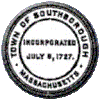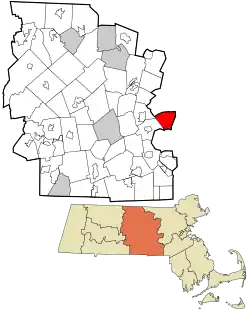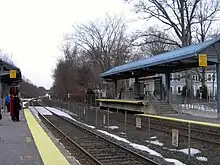Southborough, Massachusetts
Southborough is a town in Worcester County, Massachusetts, United States. It incorporates the villages of Cordaville, Fayville, and Southville. Its name is often informally shortened to Southboro, a usage seen on many area signs and maps, though officially rejected by town ordinance. At the 2020 census, its population was 10,450 in 3,542 households.[1]
Southborough, Massachusetts | |
|---|---|
 Center of Southborough | |
 Seal | |
 Location in Worcester County and the state of Massachusetts. | |
| Coordinates: 42°18′20″N 71°31′30″W | |
| Country | United States |
| State | Massachusetts |
| County | Worcester |
| Settled | 1660 |
| Incorporated | 1727 |
| Government | |
| • Type | Open town meeting |
| • Moderator | Paul Cimino |
| • Town Administrator | Mark Purple |
| • Board of Selectmen | Lisa Braccio Kathryn Cook Sam Stivers Chelsea Malinowski Andrew Dennington |
| Area | |
| • Total | 15.7 sq mi (40.6 km2) |
| • Land | 14.2 sq mi (36.6 km2) |
| • Water | 1.5 sq mi (3.9 km2) |
| Elevation | 306 ft (93 m) |
| Population (2020) | |
| • Total | 10,450 |
| • Density | 670/sq mi (260/km2) |
| Demonym | Southboronian |
| Time zone | UTC−5 (Eastern) |
| • Summer (DST) | UTC−4 (Eastern) |
| ZIP Codes | 01772, 01745 |
| Area code | 508/774 |
| FIPS code | 25-63165 |
| GNIS feature ID | 0618382 |
| Website | www.southboroughtown.com |
In 2021, 43% of land use is residential, with 35% open space, including a tenth of the town's area that is flooded by the Sudbury Reservoir.[2] Light industrial land use is concentrated along main roads, primarily Massachusetts Route 9, and there are several small business districts in the villages and along Route 9.[3]
History
Southborough was first settled in 1660 and was officially incorporated in July 1727. Southborough was primarily a farming community until mills began to tap the small rivers that ran through the town. By the end of the 19th century, Southborough was home to the manufacture of plasters, straw bonnets, boots, and shoes, among other things.
In 1727, Southborough split off as the "south borough" of Marlborough, much as Westborough had split off from Marlborough in 1717, ten years before.[4]
In 1898, the Fayville Dam was constructed to produce several reservoirs to supply a growing Boston with water. As a result, manufacturing vanished, and Southborough did not see substantial growth until the high-tech boom of the 1970s.
The Fay, Burnett, and Choate families had major impacts on the development of the town as it is today. St. Mark's Church, St. Mark's School, the Southborough Library, the Community House, and the Fay School were all built at least in part through the efforts of these families.
Geography
According to the United States Census Bureau, the town has a total area of 15.7 square miles (41 km2), of which 14.1 square miles (37 km2) is land and 1.5 square miles (3.9 km2), or 9.64%, is water.
Demographics
| Year | Pop. | ±% |
|---|---|---|
| 1850 | 1,347 | — |
| 1860 | 1,854 | +37.6% |
| 1870 | 2,135 | +15.2% |
| 1880 | 2,142 | +0.3% |
| 1890 | 2,114 | −1.3% |
| 1900 | 1,921 | −9.1% |
| 1910 | 1,745 | −9.2% |
| 1920 | 1,838 | +5.3% |
| 1930 | 2,166 | +17.8% |
| 1940 | 2,231 | +3.0% |
| 1950 | 2,760 | +23.7% |
| 1960 | 3,996 | +44.8% |
| 1970 | 5,798 | +45.1% |
| 1980 | 6,193 | +6.8% |
| 1990 | 6,628 | +7.0% |
| 2000 | 8,781 | +32.5% |
| 2010 | 9,767 | +11.2% |
| 2020 | 10,450 | +7.0% |
Source: United States census records and Population Estimates Program data.[5][6][7][8][9][10][11][12][13][14] | ||
By the census[15] of 2010, the population had reached 9,767.
As of the census[15] of 2000, there were 8,781 people, 2,952 households, and 2,426 families residing in the town. The population density was 620.7 inhabitants per square mile (239.7/km2). There were 2,997 housing units at an average density of 211.8 per square mile (81.8/km2). The racial makeup of the town was 94.47% White, 0.54% African American, 0.07% Native American, 3.52% Asian, 0.05% Pacific Islander, 0.50% from other races, and 0.87% from two or more races. Hispanic or Latino of any race were 1.50% of the population.
There were 2,952 households, out of which 47.5% had children under the age of 18 living with them, 73.9% were married couples living together, 6.0% had a female householder with no husband present, and 17.8% were non-families. 14.0% of all households were made up of individuals, and 5.5% had someone living alone who was 65 years of age or older. The average household size was 2.97, and the average family size was 3.30.
In the town, the population was spread out, with 32.1% under the age of 18, 3.7% from 18 to 24, 32.2% from 25 to 44, 23.9% from 45 to 64, and 8.1% who were 65 years of age or older. The median age was 37 years. For every 100 females, there were 99.9 males. For every 100 females age 18 and over, there were 95.2 males.
The median income for a household in the town was $132,986, and the median income for a family was $129,454, although according to CNN, median family income had risen to $148,297 by 2009.[16] Males had a median income of $80,961 versus $50,537 for females. The per capita income for the town was $64,310. About 0.4% of families and 0.6% of the population were below the poverty line, including 0.7% of those under age 18 and 4.5% of those age 65 or over.
Economy
Information technology services company Virtusa is based in Southborough.
Arts and culture
Points of interest in Southborough are:
- 9/11 Field
- Arts Center
- Community House
- Rural Cemetery
- Breakneck Hill conservation land
- Sudbury Reservoir Trail
- St. Mark's School
- Beals Preserve
- Pilgrim Congregational Church, where the funeral scene from the movie "Grown Ups" was filmed
- Boroughs Loop Trail
Annual events
Southborough celebrates Heritage Day on Columbus Day. Events include a parade with the Algonquin High School marching band. Events in the week prior include a run/walk event and pumpkin-carving.
Government
The form of town government is open town meeting, in which the voters of the town assemble as the legislature. Each Town Meeting is managed by the elected Moderator, who also appoints most of the membership of the unelected boards.
The five members of the Select Board are elected to act as the executive body of the government. The Select Board delegates day-to-day operations to the Town Administrator.
Southborough has three school committees:
- Southborough K–8 School Committee
- Northborough-Southborough Regional School Committee
- Assabet Valley Regional Vocational-Technical School Committee
Southborough's town elections are non-partisan.
Almost sixty percent of current voters registered without enrolling in any political party. Democrats slightly outnumber Republicans in the remaining forty percent. Minor party enrollments are negligible.
The State Senator is Jamie Eldridge; the U.S. Representative is Katherine Clark; and the U.S. Senators are Elizabeth Warren and Ed Markey.
Education
Public and private educational campuses frame Southborough's downtown.
Public schools
Southborough has six public schools. The four elementary and middle schools are inside town limits; the two high schools are regional schools in adjoining towns.
- Mary E. Finn School – Preschool, kindergarten, and 1st grade
- Albert S. Woodward School – 2nd and 3rd grade
- Margaret A. Neary School – 4th and 5th grade
- P. Brent Trottier Middle School – 6th, 7th, and 8th grade
- Algonquin Regional High School in Northborough, Massachusetts – 9th to 12th
- Assabet Valley Regional Technical High School in Marlborough, Massachusetts – 9th to 12th
Private schools
Southborough is home to a private secondary school, St. Mark's, which was founded in 1865 by Joseph Burnett. The oldest junior boarding school in the nation, the Fay School, was founded a year later in 1866 by Joseph Burnett's first cousin Harriet Burnett Fay.
Media
- My Southborough news blog[20]
- Community Advocate
Infrastructure

Transportation
The MBTA Commuter Rail's Framingham/Worcester Line train stops at Southborough Station, which opened to commuters on June 22, 2002. The station is located in the Cordaville neighborhood, on Route 85 near the border with Hopkinton. As of October 2007, ten daily round-trip trains provide service to Boston via the Back Bay and South Station terminals.
Interstate 495 and the Massachusetts Turnpike (Interstate 90) both pass through Southborough, although neither have interchanges within town limits. Routes 9 and 30 are east–west routes passing through Southborough, while Route 85 serves the town as a north–south route.
Notable people
- Marty Barrett, former Red Sox second baseman, who now resides in Las Vegas
- Doug Brown, former National Hockey League forward
- Ryan Gallant, professional skateboarder
- John Garabedian, radio personality
- Winfield Scott Hammond (1863–1915), Congressman, Governor of Minnesota from January 5, to December 30, 1915
- Jeffrey Johnson, actor
- Storm Large, musician and actress[21]
- Warner Oland (1879–1938), actor and star of sixteen 'Charlie Chan' movies from 1931 to 1937
- Rico Petrocelli, former Red Sox third baseman
- Mike Port, former Red Sox General Manager and executive
- E. C. Spykman (1896–1965), children's novelist and journalist
- Robert H. Thayer (1901–1984), lawyer, naval officer and diplomat
- Luis Tiant, former Red Sox pitcher
- Michael Weishan, former PBS host
References
- "Census - Geography Profile: Southborough town, Worcester County, Massachusetts". Retrieved October 27, 2021.
- "Town of Southborough 2021 Master Plan" (PDF). June 2022. Archived (PDF) from the original on July 12, 2022. Retrieved July 12, 2022.
- R.G. (August 2009). "Best Places to Live: 31. Southborough, MA". Money. Retrieved November 22, 2018.
- "An Act For Dividing The Town Of Marlborough, And Erecting A New Town There By The Name Of Southborough". The State Library of Massachusetts. Retrieved October 24, 2014.
- "Total Population (P1), 2010 Census Summary File 1". American FactFinder, All County Subdivisions within Massachusetts. United States Census Bureau. 2010.
- "Massachusetts by Place and County Subdivision - GCT-T1. Population Estimates". United States Census Bureau. Retrieved July 12, 2011.
- "1990 Census of Population, General Population Characteristics: Massachusetts" (PDF). US Census Bureau. December 1990. Table 76: General Characteristics of Persons, Households, and Families: 1990. 1990 CP-1-23. Retrieved July 12, 2011.
- "1980 Census of the Population, Number of Inhabitants: Massachusetts" (PDF). US Census Bureau. December 1981. Table 4. Populations of County Subdivisions: 1960 to 1980. PC80-1-A23. Retrieved July 12, 2011.
- "1950 Census of Population" (PDF). Bureau of the Census. 1952. Section 6, Pages 21-10 and 21-11, Massachusetts Table 6. Population of Counties by Minor Civil Divisions: 1930 to 1950. Retrieved July 12, 2011.
- "1920 Census of Population" (PDF). Bureau of the Census. Number of Inhabitants, by Counties and Minor Civil Divisions. Pages 21-5 through 21-7. Massachusetts Table 2. Population of Counties by Minor Civil Divisions: 1920, 1910, and 1920. Retrieved July 12, 2011.
- "1890 Census of the Population" (PDF). Department of the Interior, Census Office. Pages 179 through 182. Massachusetts Table 5. Population of States and Territories by Minor Civil Divisions: 1880 and 1890. Retrieved July 12, 2011.
- "1870 Census of the Population" (PDF). Department of the Interior, Census Office. 1872. Pages 217 through 220. Table IX. Population of Minor Civil Divisions, &c. Massachusetts. Retrieved July 12, 2011.
- "1860 Census" (PDF). Department of the Interior, Census Office. 1864. Pages 220 through 226. State of Massachusetts Table No. 3. Populations of Cities, Towns, &c. Retrieved July 12, 2011.
- "1850 Census" (PDF). Department of the Interior, Census Office. 1854. Pages 338 through 393. Populations of Cities, Towns, &c. Retrieved July 12, 2011.
- "U.S. Census website". United States Census Bureau. Retrieved January 31, 2008.
- "6-Figure Towns". CNN. July 21, 2009. Retrieved May 23, 2010.
- C.B. Tillinghast. The free public libraries of Massachusetts. 1st Report of the Free Public Library Commission of Massachusetts. Boston: Wright & Potter, 1891. Google books
- Southborough Library. Retrieved 2010-11-10
- July 1, 2007 through June 30, 2008; cf. The FY2008 Municipal Pie: What's Your Share? Commonwealth of Massachusetts, Board of Library Commissioners. Boston: 2009. Available: Municipal Pie Reports Archived 2012-01-23 at the Wayback Machine. Retrieved 2010-08-04
- My Southborough news blog
- Beck, Byron (September 27, 2007). "Storm Goes Large". Willamette Week. Archived from the original on January 14, 2010. Retrieved October 8, 2007.
